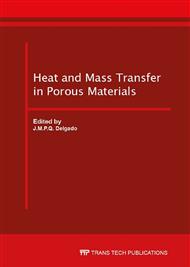[1]
48th Census of World Casting Production, Modern Casting (Dec/2014).
Google Scholar
[2]
CAEF Report, The European Foundry Industry (2013).
Google Scholar
[3]
C. Rudy, VIII TECHNICAL Foundry Conference, 12-13 May 2005, Nowa Sól, AGH, (2005), p.33.
Google Scholar
[4]
J. Campbell: Castings, Butterworth-Heinemann Ltd., (1991).
Google Scholar
[5]
L. Elmquist: Defect formation in cast iron, Jonkoping University, Sweden (2012).
Google Scholar
[6]
Information on https: /www. esi-group. com/software-services/virtual-manufacturing/casting/ procast-quikcast.
Google Scholar
[7]
Information on http: /novacast. se/products/novaflowsolid.
Google Scholar
[8]
T. Szmigielski, New version of a stand for testing resistivity of damp moulding sands. Arch. Foundry 6(22), (2006) 526–531.
Google Scholar
[9]
M. Rzeczkowski, Analysis of water circulation phenomena in the green sand moulds influenced by temperature (in Polish), Scientific Letters of WSInz, (1977).
Google Scholar
[10]
Z. Ignaszak, L. Graczyk, P. Popielarski, Experimental—simulating method of over moist zone identification in the mould. Arch. Foundry 6(22), (2006) 216–223.
Google Scholar
[11]
P.K. Krajewski, G. Pirowski, J. Buras, Thermal properties of foundry mould made of used green sand, Archives of Foundry Engineering, Volume 16, Issue 1/2016 (2016) 29-32.
DOI: 10.1515/afe-2015-0098
Google Scholar
[12]
M.P. Chowdiach, Giesserei 19, (1971) 582–590.
Google Scholar
[13]
C.T. Marek, Modern Casting, nr 2, (1968).
Google Scholar
[14]
Z. Pirowski, S. Pysz, Computer simulation of castability trials, Journal of Research and Applications in Agricultural Engineering (2013) 151-156.
Google Scholar
[15]
T. Szmigielski, Moisture of mould in condensation zone. Arch. Foundry 3(10) (2003) 249–254.
Google Scholar
[16]
T. Szmigielski, Phenomena in over-moisture zone in wet sand mould heated on one side. in Proceedings of X Foundry Conference TECHNICAL (in Polish), (2007).
Google Scholar
[17]
Chu, Shao-Shu, Fang, Te-Hua, Chang, Win-Jin, Modelling of coupled heat and moisture transfer in porous construction materials. Math. Comput. Model. 50, (2009) 1195–1204.
DOI: 10.1016/j.mcm.2009.06.008
Google Scholar
[18]
A.S. Guimarães, J.M.P.Q. Delgado, V. P de Freitas, Numerical simulation of rising damp phenomenon. Defect Diffus. Forum 326–328 (2012) 48–53.
DOI: 10.4028/www.scientific.net/ddf.326-328.48
Google Scholar
[19]
J.M.P.Q. Delgado, M. Vázquez da Silva, Performance and modelling of water vapour adsorption in piles of granules using a cylindrical pore model. Defect Diffus. Forum 312–315, (2011) 1155–1160.
DOI: 10.4028/www.scientific.net/ddf.312-315.1155
Google Scholar
[20]
H. Garbalinska, Isothermal Coefficients of Moisture Transport in Porous Building Materials (in Polish). Szczecin (2002).
Google Scholar
[21]
C. Huang, H. Ye, J. Fan, W. Sun, Numerical study of heat and moisture transfer in textile materials by a finite volume method. Commun. Comput. Phys. 4(4), (2008) 929–948.
Google Scholar
[22]
J. Fan, W. Xinghuo, Modelling heat and moisture transfer through fibrous insulation with chase change and mobile condensates. Int. J. Heat Mass Transf. 45, (2002) 4045–4055.
DOI: 10.1016/s0017-9310(02)00114-x
Google Scholar
[23]
Z. Ignaszak, Validation of foundry simulation code in terms of thermophysical parameters of moulding sand, Internal report (2013).
Google Scholar
[24]
Handbook of Thermophysical Properties (ed. ) Macmillan Comp., New York, (1961).
Google Scholar
[25]
Z. Ignaszak, Thermophysical Properties of Mould Materials in Aspect of Solidification Control of Simulation Process (in Polish). Poznan University of Technology, Poznan, (1989).
Google Scholar
[26]
P. Popielarski, Z. Ignaszak, Effective modeling of phenomena in over-moisture zone existing in porous sand mould subjected to thermal shock, Drying and Energy Technologies, Springer International Publishing, Switzerland 2016, s. 181 – 206.
DOI: 10.1007/978-3-319-19767-8_10
Google Scholar


